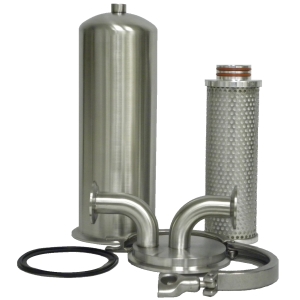Sterile Filtration for Compressed Air Systems
By Todd Witengier
The need for 100% sterile, bacteria-free, compressed air is common for a range of industries that is as varied as the applications they serve. Food processing and packaging, aseptic packaging, beverage production and bottling, brewing, dairy, and pharmaceuticals are just a few of the industries that require uncompromised sterile filtration of the compressed air and gas for their processes. Sterile filters must effectively remove and retain all bacteria and viruses, as well as other organisms and contaminants.
Sterilization filters are extremely fine filters designed for the removal of microorganisms. The proper application of sterile filters, therefore, requires pre-filtering and purifying incoming compressed air; air free of oil and water, as well as coarse contaminants. As such, it is imperative that the employed filtration model use a staged approach. Ideally, you should install sanitary industrial filters, including at least a pre-filter and coalescing filter, prior to the final sterile filter. The pre-filter will remove coarse contaminants that would otherwise dramatically reduce the service life of filters installed thereafter. You should install the coalescing filter next in line to remove any oil and water in the system. Additionally, an activated carbon filter could be installed after the coalescing filter to remove odors from the air supply. Lastly, for typical installations you situate the sterilization filter just in front of the point of use to avoid infections on the sterile side. A sterile side infection is possible in each pipeline, pipe connection, valve and tap. The recommended direction of air flow in the filter element is radiantly from outside to inside.
Once installed inline, you must sterilize the new unit prior to use to ensure 100% you achieve sterility of the operating environment. This is where many applications go awry, as out-of-the-box sterility is oftentimes assumed. There are two recommended methods to sterilize the filter. Nearly every application runs the risk of possible increased growing of bacteria at the receiver and backward growing of germs through the pipeline into the sterile filter is also possible. As such, you must sterilize each system frequently according to the specific conditions. One approach uses hydrogen peroxide, which should present no problem for the installed filter element. Check with your manufacturer to verify that your filter’s element is capable of being sterilized in this way. Upon sterilization using hydrogen peroxide as the active agent, you must drain H202 deposits from the housing prior to system operation. Another option to prepare your filter for use involves in-situ steam sterilization. Introduce steam to the sterile filter using a bypass feed line. In such case, use a steam filter to remove coarse contaminants from the compressed steam, which ensure a longer sterile filter element life. It is important to note that you must re-sterilize your filtration system each time you replace a filter element. It is also recommended that filtration systems be re-sterilized after each time the system goes through a period of shut down as bacterial grow-through can occur in inactive environments. You should replace the element if your filter reaches the permissible differential pressure of 0.7 bars to 1 bar and if a total steam sterilization cycle of 100 times or 100 hours is reached.
The manufacturer should construct their sterile filters employed with elements constructed of stainless steel inner and outer support sleeves to withstand surging in air or gas supply, as well as stainless steel end caps. They should also feature three-dimensional media layering and a 100% binder-free, sub-microfiber web with a 94% void volume to support a two-stage depth filtration model. The depth filters should operate with 99.99998% efficiency down to a particle size of 0.01 micron. The element media should also boast zero migration and zero extractibles. Problems can arise when filter elements contain binder materials, which provide a nutrient breeding ground for microorganisms, thereby encouraging grow-through. The filter elements should also be chemically, biochemically, and biologically neutral and inert, as well as resistant against chemicals and high temperatures. The elements should be able to withstand steam or H202 sterilization prior to use. Properly engineered sterile filters should also feature housings constructed of crevice-free stainless steel to ensure that they can achieve 100% sterile filtration of air and gases.
Performance characteristics to look for in a truly effective sterile filter include:
- Ability to withstand sterilization up to 200?C;
- Steam sterilization cycles up to 100 times or 100 hours;
- Suitability for in-situ standard or reverse flow steam Sterilization;
- Guaranteed 100% maintainable sterility;
- Resistance to a differential pressures of 5 Bars;
- Loading capacities between 0% to 200% of nominal flow;
- 100% element sealing by double 0-ring construction;
- Binder-free microfiber filter media to safeguard against grow through;
- Finally, both elements and housings be manufactured with minimum tolerances.
Proper selection, configuration, installation, and maintenance are all critical factors in creating and preserving a 100% sterile environment for your specific process. You must address all criteria to ensure consistent sterility. Take care to select the right filters for your system design and develop a maintenance plan that will provide a sustainable sterile environment for your application.
Lee Maddox is a Product Manager and filtration expert at Microdyne Products Corp.-a U.S.A. manufacturer of compressed air and gas filters. Microdyne specializes in sterile air and gas filters, high pressure filters, coalescing filters, and our newest line of sanitary industrial filters. We service all industries that require clean compressed air and gas for their manufacturing process. Visit our website at https://microdyneproducts.com/filter-products/sterile-filters/ to see our complete line of Sterile Filters.
Article Source: http://EzineArticles.com/?expert=Lee_Maddox
http://EzineArticles.com/?Sterile-Filtration-for-Compressed-Air-Systems&id=7851568
Related Information



Sorry, the comment form is closed at this time.